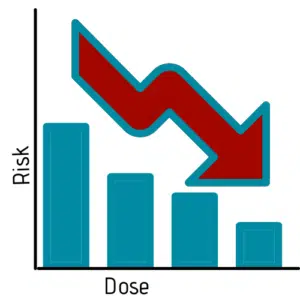
Fiber and Breast Cancer Risk: What You Need To Know Now
Do some kinds of fiber reduce breast cancer risk? As evidence grows about fiber in the diet and breast cancer risk, we may need to fine-tune questions and strategies to consider different types of dietary fiber.
Communicating nutrition messages that are both accurate and simple isn’t easy. I still remember smiling through gritted teeth while talking to a couple following a seminar that I presented on reducing cancer risk. “We’ve seen your articles and we’re excited to tell you about how we’ve added garlic to our meals.” Great, right? Until they explained, “We add a head of garlic to a salad at dinner every night.” – That’s right: not one clove, a whole bulb… never something I’ve suggested in any article or presentation. – How did what I thought was a simple idea about enjoying garlic to flavor food lead them down that path?
Dietitians encounter situations like this all the time.
Providing solid messages supported by best available research might not seem to conflict with providing simple, practical messages. – But accomplishing both goals can, indeed, be a challenge.
Amidst growing evidence about dietary fiber and breast cancer, how can we accurately communicate the complexities while providing practical advice that’s framed within the perspective from overall research?
Women consuming more dietary fiber are less likely to develop breast cancer, according to an analysis of studies involving nearly two million women. Do different kinds of fiber differ in their potential protection? Research is still drilling down to answer that question. Other details – like the sources of fiber and the overall diet – may be important details to consider before adopting these findings for strategies to reduce breast cancer risk.
Key Take-Away Points:
♦ Women who consume diets higher in fiber have lower risk of breast cancer than women with low-fiber diets in observational population studies.
♦ Different kinds of fiber might provide protective benefits through several different mechanisms.
♦ Rather than relying on any single food or supplement to boost fiber, current evidence best supports a strategy that includes steps to include more fiber from multiple different sources.
Emerging Research on the Fiber-Breast Cancer Link
Women who consume more fiber than others may be less likely to develop breast cancer. That’s the major finding coming from a systematic review of 20 observational studies (most from large prospective cohorts). The pooled analysis found that women who consumed the highest amounts of fiber had 8% lower risk of breast cancer than women consuming the least.
Since breast cancer is one of our most common cancers, it’s helpful to have some clues on potentially protective eating choices women can make in addition to the clear reduction in breast cancer risk from regular physical activity, a healthy weight, and limited or no alcohol consumption.
Fiber’s association with lower breast cancer risk in this pooled analysis is statistically significant (meaning it’s not likely to have occurred purely by chance), and the results of the different studies were relatively consistent.
But keep in mind these key points:
Fiber is not all the same. Different types offer different protective benefits. So different kinds of fiber may vary in how they influence breast cancer risk. In this combined analysis:
- Soluble fiber showed the clearest link to lower breast cancer risk. Women with the highest consumption had 10% lower risk than women who consumed the least. Even all soluble fiber is not the same. But data collected in the individual studies did not allow analysis of associations with specific forms of soluble fiber, such as viscous and fermentable fibers.
- Insoluble fiber also showed a potential link with lower risk, but it was not statistically significant. Although it’s association with breast cancer risk is especially tentative, it’s certainly valuable for other aspects of health.
Breast cancer is not all the same. Different factors tend to drive different forms of the disease. And pre- versus post-menopausal cancers occur in different hormonal environments and may be affected differently.
- Higher total fiber consumption was associated with lower breast cancer risk in both premenopausal and postmenopausal women.
- Both ER+/PR+ and ER-/PR- breast cancer risk showed potential to decrease with more dietary fiber, but in both cases, this was a trend that was not statistically significant. We need further research. Yet scientists hypothesize that the multiple mechanisms through which fiber may act show the potential to protect against both types of breast cancer.
◊ ◊ ◊ ◊ ◊ ◊ ◊
Are you trying to find new ways to look at dietary fiber consumption?
For a free pantry checklist and tip sheet (plus a dietitians’ all-in-one-place cheat sheet),
Click Here.
◊ ◊ ◊ ◊ ◊ ◊ ◊
Fiber and Breast Cancer: The Research in Perspective
What’s special about this systematic review? Of the 20 studies included in this analysis by Farvid and colleagues, 17 were prospective cohort studies with long-term follow-up; two were case-control studies and one was a clinical trial. They excluded case-control studies to minimize recall and selection biases and did not include any research that was simply a cross-sectional comparison.
Is fiber itself protective? Fiber and other components of a healthy diet can be markers of other protective influences. The individual studies adjusted for a variety of potential confounders. For most of them, this included age, BMI, smoking, alcohol, family history and other classic breast cancer risk factors. Authors of this pooled analysis found no consistent differences in the association of fiber and breast cancer related to differences in alcohol, smoking, family history or calorie consumption.
- However, they could not adjust for differences in consumption of the many other potential protective compounds in high-fiber foods. Carotenoids, polyphenols and others show potential to promote defenses like DNA repair, antioxidant and anti-inflammatory defenses, protective changes in gene expression, for example. So we cannot assume that the risk reduction was necessarily due to fiber alone.
How much fiber does it take? This analysis pooled results of studies involving people who differed in amounts and sources of fiber. Although higher fiber consumption was consistently associated with lower breast cancer risk compared to low fiber consumption, the amount of fiber categorized as “high” or “low” fiber was not consistent across individual studies.
- Dose-response analysis provides insights on fiber amounts. The AICR Continuous Update Project includes an analysis of 16 studies, though this analysis was conducted before publication of three of the studies included in the analysis by Farvid and colleagues. The AICR dose-response analysis shows 5% lower risk of breast cancer for each 10 grams of dietary fiber. And analysis in the Million Women Study of postmenopausal UK women, published after the AICR analysis, found a 9% lower risk of postmenopausal breast cancer risk for each 5 grams per day increase in dietary fiber.
- The body of evidence supporting physical activity to reduce breast cancer is stronger than for dietary fiber. But that 5% reduction in breast cancer risk per 10 grams of fiber is similar to the reduction in risk from exercise that meets the minimum recommendation of 150 minutes of moderate activity per week. [The AICR systematic literature review found 5% risk reduction per 10 MET-hours per week of recreational physical activity.]
What about Breast Cancer Survivors? 
Much less evidence is available to answer that question. WCRF/AICR CUP Global analysis of studies links higher dietary fiber consumption after breast cancer diagnosis with lower risk of all-cause mortality. However, with few studies in this analysis, the expert panel graded the evidence “Limited Suggestive,” meaning it’s not strong enough to support any specific recommendation. A slight trend for lower breast cancer mortality with higher post-diagnosis dietary fiber was not statistically significant (meaning it could occur by chance). The panel graded this evidence too limited to draw conclusions.
Another meta-analysis found total dietary fiber linked with lower all-cause and breast cancer mortality in prospective cohort studies of breast cancer survivors. (Of note, the quality of evidence on breast cancer mortality was rated as low quality, so the strongest association is for reducing risk of death from all causes.) In this analysis, women who had pre- and postmenopausal breast cancer both showed lower mortality. And risk reduction remained even after adjusting for weight and physical activity.
How Could More Fiber Help Prevent Breast Cancer?
It’s possible that other elements of a high-fiber diet stand behind the association of increased fiber consumption with lower breast cancer risk in observational studies. However, other types of research show mechanisms through which different kinds of fiber could be protective.
- Hormones: Most breast cancer in the U.S. is estrogen receptor-positive (ER+), meaning estrogen fuels its growth. Some studies suggest that viscous types of fiber might bind to estrogen secreted in the gut, reducing intestinal reabsorption, and thus reducing levels of estrogen circulating in the blood. That leaves less estrogen available to promote growth of estrogen-sensitive breast cancer.
Elevated levels of insulin and insulin-like growth factor 1 (IGF-1) seem to act as growth factors promoting development of both ER+ and ER- breast cancer. Fermentable fiber, viscous fiber, and insoluble grain fiber have each shown potential to decrease insulin resistance. However, significant inconsistencies in results signal need for further research. How much insulin resistance changes with increased fiber likely differs depending on people’s baseline insulin sensitivity, as well as other factors.
- Inflammation: Research is in progress studying whether dietary fiber might reduce chronic, low-grade inflammation that promotes development of heart disease and cancer. In the HEAL study of early-stage breast cancer survivors, women who consumed more fiber were less likely to have elevated levels of a marker of inflammation (C-reactive protein, known as CRP) compared to women consuming diets low in fiber.
In this study, intake of insoluble fiber stood out, with the top third of intake tied to about 50% lower odds of elevated CRP. Yet other research suggests that types of fiber that gut bacteria can fermented to form protective compounds may be most effective in reducing inflammation. Fiber’s influence on inflammation might also vary among different individuals depending on baseline levels of inflammation and other personal characteristics.
- The Gut Microbiome: You may not have considered bacteria and other gut microbes as likely influences on breast cancer risk, but emerging research suggests the intestinal microbiome could play a role in all the above mechanisms. Gut microbes are involved in regulation of estrogen metabolism and affect the level of systemic estrogens. In addition, gut microbes ferment certain kinds of fiber, producing short chain fatty acids such as butyrate. Studies show that butyrate can reduce insulin resistance and inflammation, although much of this evidence comes from animal studies and small human trials. Amounts and types of fiber in the diet influence the gut microbiome, so more research is needed on this potential link to breast cancer.
Breast tissue has a microbiome, too, that seems likely to affect cancer risk. But research is still far from showing if and how diet may influence those populations.
What About Fiber and a Healthy Weight?
Most foods supplying dietary fiber provide relatively few calories in a substantial portion. Fiber’s bulk may lead people to feel full on fewer calories, thus helping to reach and maintain a healthy weight. Emerging evidence suggests that some forms of fiber may go further, and influence gut hormones involved in appetite control.
Excess body fat and weight gain are strongly tied to postmenopausal breast cancer risk, likely due to effects increasing estrogen levels, insulin resistance and inflammation. So effects on weight may be part of a link between higher fiber consumption and lower breast cancer risk.
However, almost all the studies in the analyses by AICR and by Farvid and colleagues adjusted for body mass index (BMI), calorie consumption, or both – and still found an association of higher dietary fiber with lower breast cancer risk. That suggests boosting fiber consumption may help lower breast cancer risk even beyond any support for weight management.
What’s the Best Advice for Women About Fiber?
To put this research in perspective, consider these results from breast cancer studies in the bigger picture of research on diet for lower overall cancer risk and good health.
How to Think Big about Fiber 
Most women should be advised to eat more fiber, though not solely to reduce breast cancer risk.
- Women in these breast cancer studies consuming the least amount of fiber generally took in about 12 to 16 grams per day. That’s typical fiber consumption for 25% to 50% of U.S. women. And it’s well below levels associated with overall good health and lower colon cancer risk.
- Women categorized as high fiber consumption – who showed lower breast cancer risk – weren’t eating extreme amounts. They generally ate 25 to 30 grams of fiber per day. That means they at least met the minimum recommended for good health, and in some cases reached slightly higher levels consistent with a diet that lowers colorectal cancer risk.
- What about Dietary Reference Intakes (DRIs) recommendations that call for at least 25 grams per day for women up to age 50, but lower the bar to 21 grams per day for women over 50? First, the actual DRI is based on 14 grams per 1000 kcals. Based on average calorie consumption, that calls for more than 21 grams of fiber per day even for many older women. Second, the fiber DRIs are based on heart disease risk, not evidence about reducing risk of cancer.
How to Set a Smart Target for Dietary Fiber 
To support behavior change and digestive system tolerance, meet a woman at her starting point and make small steps to increase fiber. But with average dietary fiber consumption by U.S. women at 15.5 grams per day, most of us need to do more than just grab one extra piece of fruit each day.
- Dose-response analysis in the AICR report shows a threshold of 35 grams of fiber per day at which reduced risk of breast cancer is clearly statistically significant.
- On the other hand, especially among postmenopausal women, an increase of 5 to 10 grams of fiber per day is associated with a reduction in breast cancer risk that is statistically significant.
- No available evidence supports a breast cancer benefit by pushing to extremely high fiber intake.
How to Choose Strategies to Boost Fiber 
We are still waiting for research that can clarify the role of different kinds of fiber in reducing breast cancer risk. So here’s an approach to address the yin-and-yang pull of accurately communicating current science and providing simple, practical action steps.
1. Get fiber from a variety of different foods.
Soluble fiber stands out, not only in the analysis of high versus low fiber by Farvid and colleagues, but also in the AICR dose-response meta-analysis. Every 10-gram increase in soluble fiber showed a 26% lower breast cancer risk.
But when it comes to creating a dietary strategy, remember that “soluble fiber” is not all the same. Differences in viscosity (tendency to form a gel when mixed with water) and fermentability (ability for healthy bacteria in our gut to use it to produce health-promoting substances) likely result in different effects. So a simple list of foods high in soluble fiber is not the answer when people ask, “What foods have prebiotics?”
- Fiber from fruits is particularly linked with lower breast cancer risk in both the high-low analysis by Farvid and colleagues and the dose-response analysis by AICR. Many fruits – such as apples, pears, oranges, grapefruit, and bananas – supply soluble fiber. But fruits also bring a variety of nutrients and phytochemicals. And they provide a way to satisfy a sweet tooth with a choice that’s not very concentrated in calories. Eating more fruit is a great idea. Just don’t rely on that as the whole strategy.
- Pulses — such as chickpeas; lentils; and black, kidney and pinto beans – are rockstars as sources of both viscous and fermentable soluble fiber. Be cautious about how you interpret decreases in risk of breast cancer (or other chronic diseases) that aren’t statistically significant in comparisons of high versus low intake. In many Western populations, even the “high” consuming group may not be consuming very much. The AICR dose-response meta-analysis found a 7% to 8% decrease in breast cancer risk for each six to eight grams of fiber per day from legumes. (That’s the equivalent of about a half-cup of dried beans or peas a day.)
- Other plant foods, including certain whole grains, vegetables, and seeds are also important sources of soluble fiber. And all help increase the variety of types of fiber and potentially protective nutrients.
Don’t zero in too tightly on soluble fiber. The insoluble fiber you get from whole wheat and other whole grains, as well as many vegetables and nuts, seems linked to lower weight and waist gain, and to other health benefits.
For lower risk of breast or other cancers, for now there is no clear advantage to boosting fiber with any particular food source or type of fiber. The simple message: aim for a variety of whole plant foods as the largest part of each meal and snack.
Breast Cancer Survivors: Attention to heart health is important, too.
Whether because of risk factors present before a breast cancer diagnosis or because of increased risk due to certain cardiotoxic breast cancer treatments, many breast cancer survivors are at greater risk of death from cardiovascular disease than women who have never had cancer. Paying attention to CVD risk factors is still important for healthy eating.
When extra help is needed to reduce LDL cholesterol, 5 to 10 grams of viscous fiber daily is recommended. Randomized controlled trials show this can produce a 4% to 10% reduction in LDL cholesterol in addition to the lipid drop from reducing saturated fat and from statin medications. For some women, a viscous fiber supplement may be helpful to reach this target.
Want more on how healthy eating can address both? Check my research review on breast cancer and heart disease.
2. Start with food, rather than supplements.
Fiber from isolated sources does show protective effects. But the benefits are limited to those of that single type of fiber.
- Research hasn’t yet clarified how much of any breast cancer protection comes from fiber or from other components of high-fiber foods – much less which type or types of fiber are most effective. For now, don’t count on fiber alone to anchor your strategy for lower breast cancer risk.
- Fiber-fortified foods or fiber supplements may still be helpful for individualized reasons, such as avoiding constipation or reducing LDL cholesterol – as long as the appropriate type of fiber is selected.
3. Focus on swaps to boost high-fiber foods.
As you aim for lower breast cancer risk, remember the strong role of a healthy weight.
- Use higher-fiber foods as replacements for other foods, ideally some less nutritious choices.
- Don’t let fiber content from added isolated fiber distract you with a “health halo” if a food is low in nutrients or high in calories.
Bottom Line on Kinds of Fiber and Breast Cancer Risk:
It’s possible that “fiber” or “soluble fiber” is a marker for a whole range of protective compounds in high-fiber foods. If further research establishes fiber (or any particular kinds of fiber) as the true protective factor, then fiber supplements or foods with added isolated fibers could be part of the toolbox of strategies. For now, keep the focus on increasing amounts and variety of foods rich in both fiber and nutrients.
Need resources to help people work in more high-fiber foods? You’ll find ideas for including more vegetables and fruits here from Produce for Better Health. Check here and expand your world of whole grains with help from the Whole Grains Council. And the Half-Cup Habit information from USA Pulses is just what you need if you want to find more ways to use dried beans, peas, and lentils.
For detailed listing of fiber content in foods, check the USDA National Nutrient Database. In the left sidebar, under Component, you can choose to search total dietary fiber, soluble fiber, or insoluble fiber. Underneath that, select whether you want results sorted by 100-unit serving (usually 100 grams) or by serving size.
- Remember that a food may seem high in fiber per 100 grams, but be far less concentrated a source based on portion consumed.
- Although you’ll see a single figure for soluble fiber, remember that it’s not all the same.
Check here for a brief summary from the American Institute for Cancer Research/World Cancer Research Fund Third Expert Report. It highlights the steps that research most strongly supports as ways to reduce breast cancer risk.
For a more detailed summary of the AICR/WCRF Third Expert Report section on breast cancer, check here, where you will also find a link to the full chapter on breast cancer risk.
World Cancer Research Fund/American Institute of Cancer Research, Continuous Update Project Expert Report 2018. Diet, nutrition and physical activity: Energy balance and body fatness. Available at dietandcancerreport.org
Becerra-Tomás N, Balducci K, Abar L, et al. Postdiagnosis dietary factors, supplement use and breast cancer prognosis: Global Cancer Update Programme (CUP Global) systematic literature review and meta-analysis. Int J Cancer. 2023 Feb 15;152(4):616-634. doi: 10.1002/ijc.34321.
Chen S, Chen Y, Ma S, et al. Dietary fibre intake and risk of breast cancer: A systematic review and meta-analysis of epidemiological studies. Oncotarget. 2016;7(49):80980–80989. doi:10.18632/oncotarget.13140
*Note that the analysis of prospective cohort studies shows a significant effect that has less heterogeneity than analysis that includes case-control studies, which are a methodologically weaker type of study.
Farvid MS, Spence ND, Holmes MD, and Barnett JB. Fiber consumption and breast cancer incidence: A systematic review and meta‐analysis of prospective studies. Cancer. 2020;126:3061-3075.
Jacobson TA, Maki KC, Orringer C, et al. National Lipid Association Recommendations for Patient-Centered Management of Dyslipidemia: Part 2. J Clin Lipidol. 2015;9(6 Suppl):S1-122.e1.
Jayedi A, Emadi A, Khan TA, Abdolshahi A, Shab-Bidar S. Dietary Fiber and Survival in Women with Breast Cancer: A Dose-Response Meta-Analysis of Prospective Cohort Studies. Nutr Cancer. 2020 Aug 14:1-11.
Key TJ, Angela B, Bradbury KE, et al. Foods, macronutrients and breast cancer risk in postmenopausal women: a large UK cohort [published correction appears in Int J Epidemiol. 2018 Dec 5]. Int J Epidemiol. 2018;48(2):489–500. doi:10.1093/ije/dyy238
Kwa M, Plottel CS, Blaser MJ, Adams S. The Intestinal Microbiome and Estrogen Receptor-Positive Female Breast Cancer. J Natl Cancer Inst. 2016;108(8):djw029.
McNabney SM, Henagan TM. Short Chain Fatty Acids in the Colon and Peripheral Tissues: A Focus on Butyrate, Colon Cancer, Obesity and Insulin Resistance. Nutrients. 2017 Dec 12;9(12):1348.
Parida S, Sharma D. The Microbiome–Estrogen Connection and Breast Cancer Risk. Cells 2019;8(12):1642.
Thompson SV, Hannon BA, An R, Holscher HD, Effects of isolated soluble fiber supplementation on body weight, glycemia, and insulinemia in adults with overweight and obesity: a systematic review and meta-analysis of randomized controlled trials. Am J Clin Nutr. 2017 Dec;106(6):1514-1528
Villaseñor et al. Dietary fiber is associated with circulating concentrations of C-reactive protein in breast cancer survivors: the HEAL study. Breast Cancer Res Treat, 2011; 129(2):485-94.
Woman with magnifying glass: Igor Andriianov © 123rf.com – 8583639
Pink ribbon breast cancer survivor: burdun © 123rf.com – 113043860
Light bulb: lightwise © 123rf.com – 39948984
Think big with arrow: Nednapa Chumjumpa © 123rf.com – 79486814
Plate in bullseye target: Nikola Roglic © 123rf.com – 43532046
2 Comments
Leave a Comment
Published : January 5, 2021 | Last Updated: August 4, 2023
Tagged: breast cancer, breast cancer survivors, cancer prevention, cancer survivors, dietary fiber, fiber, healthy diet, reducing cancer risk
Meet the author/educator
I Take Nutrition Science From Daunting to Doable.™
As a registered dietitian nutritionist, one of the most frequent complaints I hear from people — including health professionals — is that they are overwhelmed by the volume of sometimes-conflicting nutrition information.
I believe that when you turn nutrition from daunting to doable, you can transform people's lives.
Accurately translating nutrition science takes training, time and practice. Dietitians have the essential training and knowledge, but there’s only so much time in a day. I delight in helping them conquer “nutrition overwhelm” so they can feel capable and confident as they help others thrive.
I'm a speaker, writer, and nutrition consultant ... and I welcome you to share or comment on posts as part of this community!










Very thorough! Thank you for such great resources.
Thanks for the positive feedback, Jill. I’m glad you found it helpful.